Before there were S.L.U.G. Queens
The S.L.U.G. Queen slid into the Eugene popular culture in 1983, the same year the Eugene City Council approved an annual city wide event called “The Eugene Celebration” (1983-2015). While The S.L.U.G. Queen shares a birthdate with the now defunct Eugene Celebration and many locals associate the The S.L.U.G. Queen with the colorful S.L.U.G. Queen float in the parade, the two were never formally affiliated. In fact, the concept of a slug icon showcasing the rebellious spirit of a creative North West city was formed as an act of rebellion itself…the more subversive City Councilors preferred the celebration to be called “Slugfest” but the conservation Eugene Celebration moniker won by a single vote of the council. In joyful defiance, the spurned City Councilors built a huge Slug Float and entered it into the parade. Sitting astride the slug’s head was the very first S.L.U.G. Queen, Queen Bruce, a local bicycle maker. The float and the S.L.U.G. Queen were a hit. The crowds loved the Slug and the S.L.U.G. Queen and the powerful symbol of bucking the establishment right there in it’s very core.
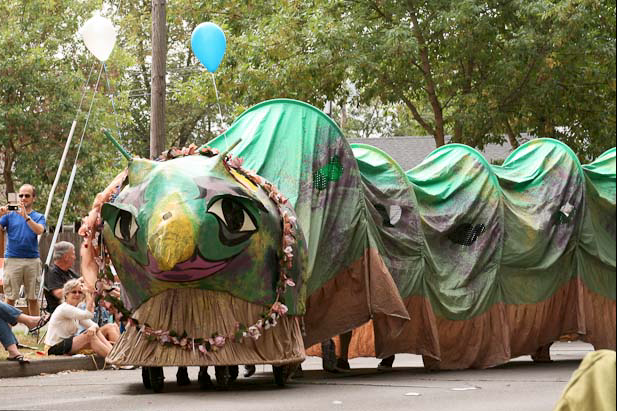
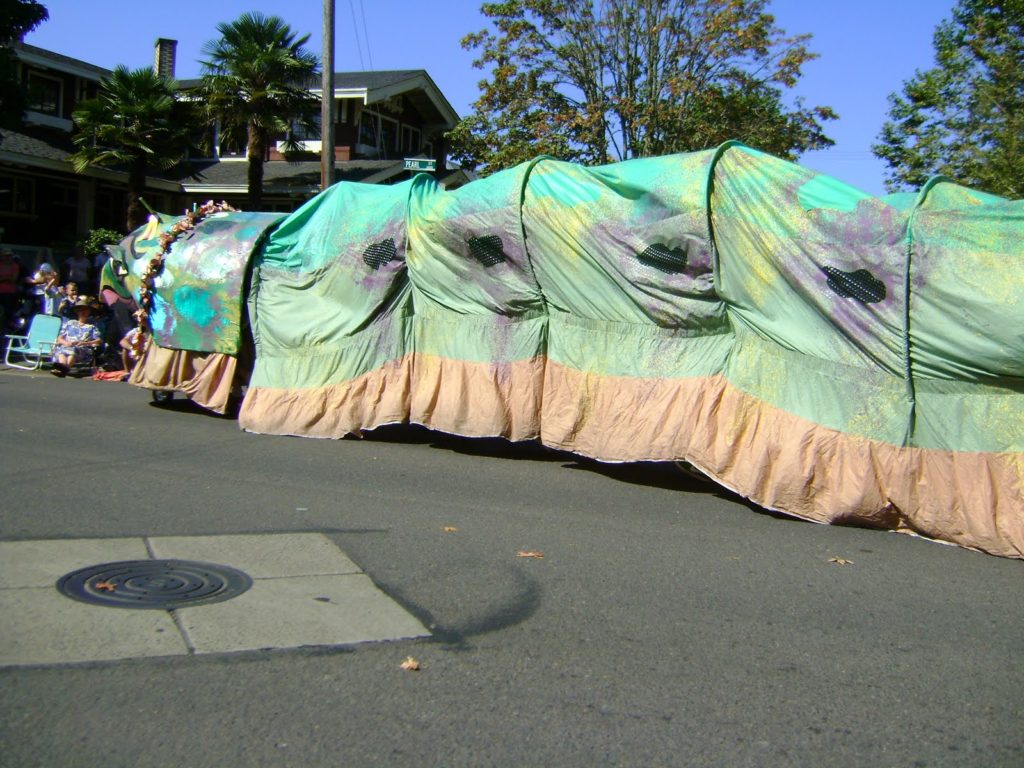
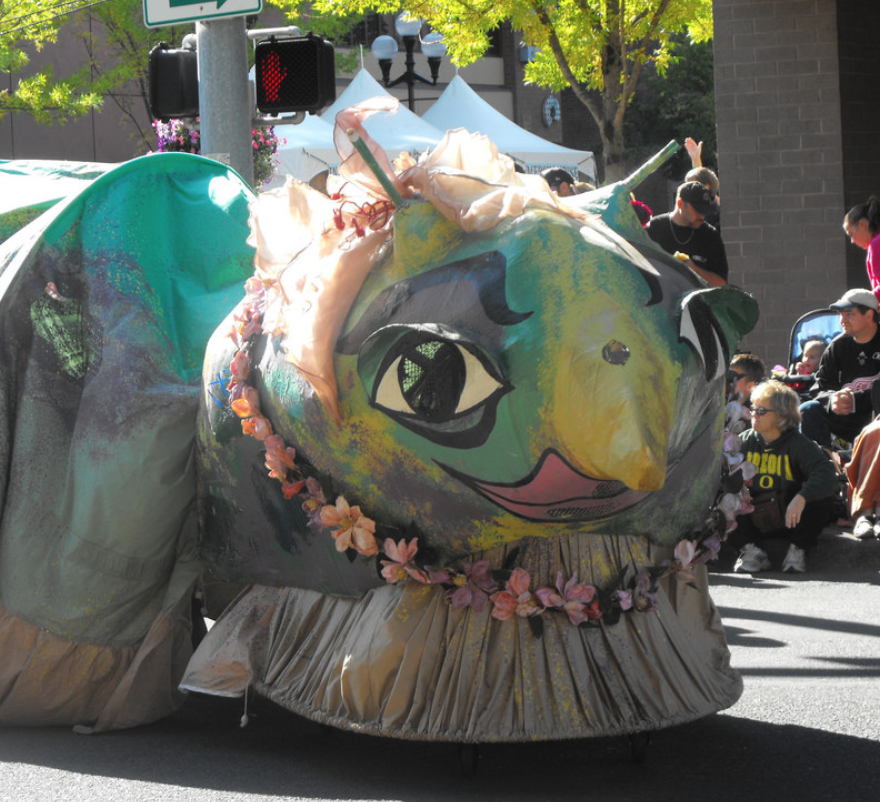
Since that first Parade in 1983, Congressmen Peter Defazio has trailed behind the S.L.U.G. Queen during the parade with his wheel barrow ready to scoop up the political slime from Washington DC
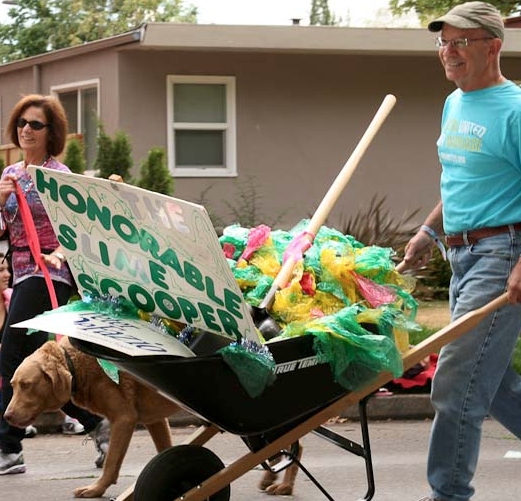
But the history of the S.L.U.G. Queen has roots deep in the history and growing pains of this pioneer town and its desire to celebrate it’s accomplishments through pageantry. It really all stated in 1926.
Klatawa, Trail to Rail (1926): Eugene’s Original Celebration
In 1926, the Southern Pacific railroad completed a new rail line between Klamath Falls to Eugene. This less harrowing cutoff through the Cascade Mountains made Eugene, a significant transportation hub. Members of the Eugene Chamber of Commerce formed the Trail to Rail Association who decided to create a pageant to celebrate Lane County.
They called this first celebration the Klatawa (Chinook for “to travel”) Trail to Rail pageant. The Chamber’s intention for the pageant was to display Eugene’s modernity by re-enacting Oregon’s advancement from dangerous pioneer trails to easy transcontinental rail travel.
The Oregon Trail Pageant included industrial and pioneer parades, dances, contests and concerts leading up to a reenactment of the Oregon Trail activities. During the entire week of the celebration men, young and old, had to compete in the “whiskerino” contest or pay a fine for sporting a shaven face. In the midst of the festivities a pageant was held to elect a civic minded young woman from Lane County to be “Queen Susannah”.
Queen Susannah: Old Susannah don’t you cry for her
Morning Register (July 22, 1926) described the “Queen Susannah Contest” as a huge draw for crowds to Eugene. Local clubs and businesses supported candidates and sponsoring groups held variety shows, swim contests, concerts by contestants, fireworks displays, dances, bridge and whist parties. Businesses invested in these displays to gain purchased votes for their Queen candidate- an early facsimile to The S.L.U.G. Queens acceptance of bribes by contestants in deference to the political corruption. Vote cards could be clipped for free from the two Eugene newspapers. In much the same way that online crowdsourcing, crowd voting, and crowd funding function today, businesses of the time offered additional vote cards, as well as special deals and contests (bean counts, a certain number of votes per purchase, etc.) to encourage people to purchase their goods. It should be noted that restaurants and the three town theatres usually sold the most vote coupons in a week.
Between the inaugural pageant in 1926 through the final pageant in 1950, the community of Eugene influenced local and statewide presentations of some of the largest known history pageants recorded in the Northwest.
Unfortunately, the Oregon Trail Pageant only expressed the prevailing norms of the white settlement identity over those of the local Kalapuya inhabitants. It celebrated the establishment of industry, farming, logging and other means of “taming” the land for the newer residents of Oregon, particularly within the Willamette Valley. By 1950 the exclusive nature of the festival was recognized and contributed to the decision to halt Trail to Rail.
It would be 33 years before Eugene had something to celebrate again.
In 1982, The Hult Performing Art Center Opens
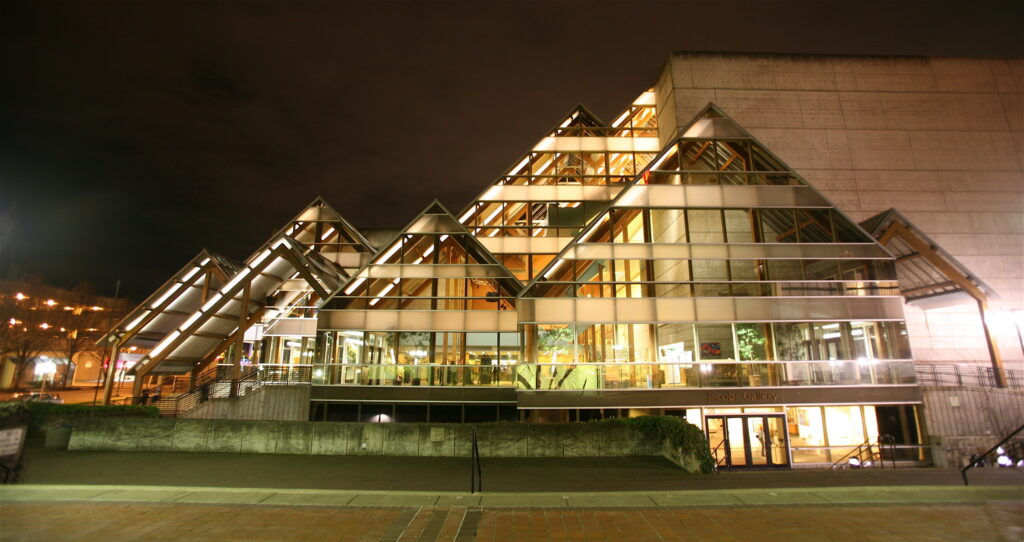
That summer, more than 25,000 people converged downtown for a public celebration of Art and Culture in the heart of Oregon. Eugene city officials were determined to launch an annual festival that would similarly bring the community together but they wanted a celebration that was truly inclusive. City council tussled over the name. More conservative city councilors suggested Eugene Celebration as a name. In a tongue-in-cheek protest over the blandness of that name, local popular cartoonist, Paul Ollswang, suggested that the festivities instead be called the more colorful “Slugfest”. “Some of us thought it was important not to take ourselves too seriously as a city,” then-City Councilor Cynthia Wooten recounted recently. “We wanted to call this event the Eugene Slugfest in honor of Eugene’s most indigenous fauna. But a majority of city leaders opted for the more generic but less slimy “Eugene Celebration.”
By way of lighthearted protest, Wooten and friends seized the “Slugfest” idea and held a unisex S.L.U.G. Queen Pageant, in her own garden that spoofed all beauty pageants. Ollswang developed the acronym SLUG: Society for the Legitimization of the Ubiquitous Gastropod. Together they created a gastropodous entry for the very first Eugene Celebration parade: a giant, Chinese dragon-style slug accompanied by the first appointed S.L.U.G. Queen- former Eugene bicycle shop owner Bruce Gordon. Celeste LeBlanc designed the 150-foot fabric slug, and friends helped sew it in the Whiteaker Community School Gymnasium.



Approximately 35 pairs of human feet were needed to propel the massive slug, which launched the original free wheeling spirit of the Eugene Celebration. Thereafter, the celebration and the S.L.U.G. Queen seemed permanently “enslimed” and has remained close since the former Special Events Coordinator for the Celebration, Carol Brewster, took a closer role in assisting with S.L.U.G. Queen coronation events under the name Queen Mother.
After two years of insider selections for the office of S.L.U.G. Queen, the now popular competition was opened to the general public, complete with rules admonishing contestants to “be tastefully tacky, but not gross or disgusting.” Gaudy is good. “Slime green” is a favorite color. Pretty much anything with a PG rating goes—the wilder, bigger, tackier, sluggier—the better. Officially, S.L.U.G. Queens are now selected on the basis of talent, costume and wit (determined by answering a question with humor in parody of the “interview” segment of many beauty pageants), and a little bribery (creative bribes are preferred).
While many attempted to bring the S.L.U.G. Queen under the organizational rules of the Eugene Celebration, The S.L.U.G. Queen steadfastly retained consistent independence. “It’s fabulous because we’re still free, free-spirited and don’t answer to anyone,” said 1997 Queen Bagonda, whose alter ego Kevin Henry worked for a local disability rights group. “If we became an official event, we’d have to come under their control. You just don’t control a queen!”
S.L.U.G. Queens are widely admired for their philanthropic work, as much as their campy counter culture appeal. Since the S.L.U.G. Queens of the late 1990’s competitors have connected with local not for profit institutions to promote community spirit and bring attention to local need. This aspect of the S.L.U.G. Queen pageant is the modern, albeit more philanthropic, version of the Old Queen Susannah’s connection to local business benefactors. All Old S.L.U.G. Queens continue to promote local business, art and culture in Eugene in perpetuity. Charity Organizations with ties to S.L.U.G. Queens include: Women’s Space, Food for Lane County, Greenhill Animal Shelter, The Lane Arts Council, Birth to Three and WAG (Animal spay and neuter Clinic), among many.




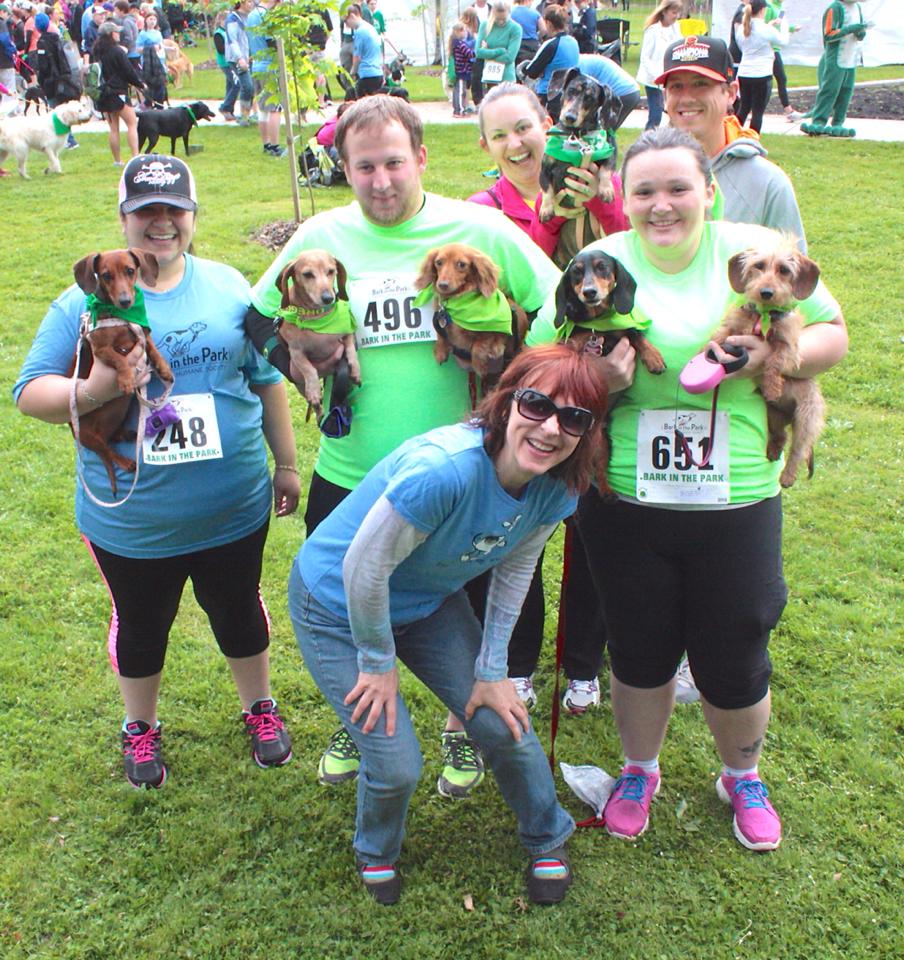
As per the nature of Slugs, gender is not an issue with the S.L.U.G. Queen. To date, eight S.L.U.G. Queens have been men–from a drag queen to a Catholic father of seven. Gender, age, race, ablism and physical appearance are not factors in the contest to become S.L.U.G. Queen. Creative candidates “with a lot of wisdom and a good understanding of Eugene politics already under their belts,” says Queen D’Arcy (actor/singer Darcy DuRuz), “have the advantage”.
S.L.U.G. Queens status increases with age and advancement of rank to stages of “Old Queen”. This allows Old Queens to campaign with clout for their charities long after their year long “rain”.
The Eugene Library
S.L.U.G. Queens raised more than $5,000 for the new Eugene Public Library in a lighthearted battle with The Comic News for naming rights to the restrooms. The gastropods prevailed and now the bathrooms are officially called “S.L.U.G. Queen Throne Rooms”.
Celebrity supporters of the S.L.U.G. Queen include US Senator Peter Defazio, who has been a parade participant and loyalist for years, Academy Award Winner and Independent Film Director James Ivory (Howard’s End, Room with a View) a Klamath Falls native and UO Alum, and S.L.U.G. Queen Bananita’s Harvard classmate, Political satirist, Al Franken.
